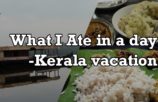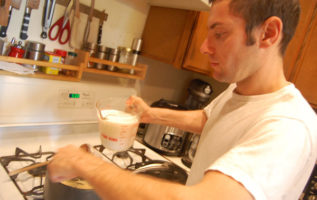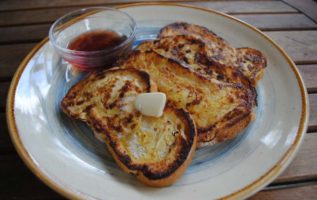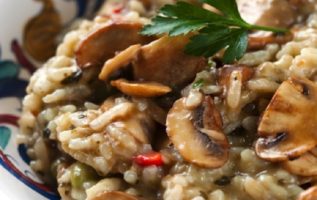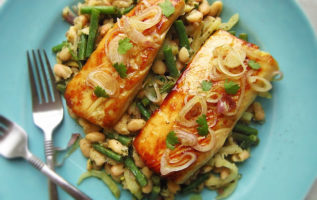
If your idea of homemade mashed potatoes entails grabbing a box and adding water, it’s time for a culinary reality check.
Sure, those instant potatoes that come from a cardboard container are passable when you’re craving the comfort that is a fluffy mound of spuds, but you may be surprised to know that making mashed from scratch isn’t a whole lot harder — and the results taste way better.
When extras such as herbs and aromatics — in this case rosemary and garlic — join the party, mashed potatoes rise to a whole new level.
In addition to offering some serious comfort and pairing with an array of dishes as a side-course superstar, one of the best qualities of mashed potatoes is that they are so cheap to make. I’m talking cents, not dollars.
I recently bought a 10-pound bag of big ‘ol russet potatoes from Food 4 Less for a buck. I don’t know of many other foods that you can buy in a 10-pound quantity for the same price as a pack of gum.
So forget that box of dehydrated flakes that tries to pass itself as mashed potatoes. Gather a few spuds and a little over half an hour of time: We are going to make a dish that would make Idaho proud.
NO FLAKIN’ GARLIC-ROSEMARY MASHED POTATOES
(Serves 4-6)
- 5 medium-large russet potatoes, skins peeled and cut into large chunks (if you like the skins on, scrub well before dicing)
- 5-6 fresh garlic cloves, minced (or use 2 tablespoons of garlic in a jar)
- 1 1/2 teaspoon of dried rosemary, chopped
- half cup to 1.5 cups of whole milk
- 2 tablespoons butter
- 2 teaspoons salt
- 1/2 teaspoon black pepper.
- Garnish: Butter, additional dried rosemary and dried thyme
Step 1: The main ingredient in mashed potatoes is, of course, the humble potato. While there are various types of spuds, good old russets work great. They may also be labeled “Idaho.” Unlike smaller potatoes known for their “waxy” texture, russets have a higher starch content, which works out great for mashed potatoes because they tend to break down more easily. Scrub them well over running water if you want to leave the skins on. Otherwise, peel them off.
Step 2: Dice the potatoes into chunks. Please don’t stress about making perfect cuts. It’s not important that these look perfect because they are all going to meet the same mashing fate. What you do want are cuts of a similar size. This way, they will all cook at an even rate. Otherwise, small chunks would cook too much, while the big ones wouldn’t get done enough.
Step 3: Fill a big pot (8 quarts or more should do) with cold or room-temperature water and add the chunks of potatoes as you cut them. Dumping them in water will keep them from turning that nasty brown color — something you might notice also happens when you cut a banana or apple and leave it too long without eating. This browning is a form of oxidation, and all that means is the air (made mostly of — you got it — oxygen) is reacting with the exterior of the food. This won’t necessarily affect flavor, but it sure isn’t very appetizing to look at.
Step 4: Once all the potatoes are in the pot, make sure the water covers them. It doesn’t have to be by much, but they do need to be submerged. You may be wondering why we are starting with water that isn’t or boiling or even hot. The reason is because we want everything to come up to temperature at the same time. If you throw the potatoes into boiling water, the exterior will cook first and can turn mushy before the insides are done.
Step 5: Put the pot on the stove over medium-high heat. You can cover if you want it to come up to a boil faster. Once boiling, though, take off the lid so you don’t risk a Jacuzzi-like bubble-fest in the waters below. In the meantime, cut the garlic cloves into small pieces. The easiest way to get them out of their papery skins is to smash them with a flat surface like the back of a knife, remove the cloves, and mince or run them through a garlic press like this one. I also like to chop the rosemary a bit; it’s prone to sticking in your teeth if the pieces are too big.
Step 6: Almost there. Let the potatoes cook until they’re fork-tender. This, of course, means until they can be pierced with a fork and the tines can be removed without resistance. How long will this take? Depends on a lot of things, including how big your pot is and its conductivity, how high you have the heat on, and even the elevation you’re cooking at. Count on about 15 minutes from when it comes to a boil.
Step 7: When the potatoes are fork-tender, drain them in a colander (and don’t let the boiling water splash you!). Shake and then put the potatoes back in the pot on the stove, with the heat on very low for about a minute or two; this will help remove any lingering water. Microwave the milk, starting with half a cup (4 ounces) until is hot but not boiling. We heat the milk so it incorporates better with the spuds and doesn’t bring the overall temperature down.
Step 8: Add the rosemary and garlic to the potatoes, followed by the milk. Grab a potato masher and start going to town. Mash until it has the consistency you like. (Alternatively, you could use a potato ricer if you have one. They are kind of like a huge garlic press.) Here’s where you’ll also add extra milk, salt and pepper to get the taste and consistency that you like. If you really want them creamy, you can put everything in a mixer, too. Just don’t mix too fast or your potatoes can turn to glue.
You’re done! All that’s left is to put the mashed potatoes in a big dish, garnish with a pat of butter and some extra herbs, and dive in.
Sure, making mashed from scratch takes a little more effort, but I think you’ll agree that the payoff is well worth the effort. And now that you have the foundation for mashed potatoes, you can experiment with incorporating other flavors into this creamy canvas. One of my favorites: a healthy dose of chunky blue cheese dressing.
Did you try this recipe? Write about your experience, ask questions or share advice in the comments area below.
Source: iwanttocook.com (defunct blog)














